
Members Visits - Heritage Trail - July 27th 2013
This year’s boundary walk, is of fairly flat terrain and takes in some of the Parishes least known landmarks and history of the not too distant past. The duration of the walk is approx one and a half hours.
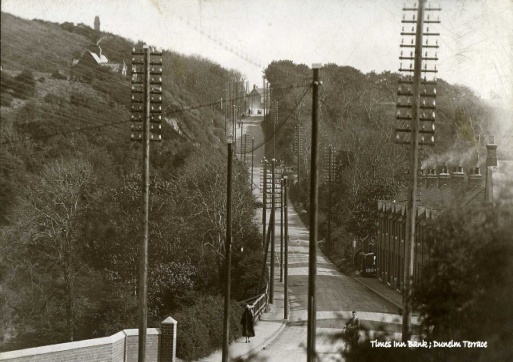
As we leave the hostelry known as the Times Inn and turn left approx 200yds on the left is a Second World War pill box hidden by trees and undergrowth. During May 1940 the branch of the Directorate of Fortifications at the War office was set up. Its purpose was to provide specific pill box designs to be constructed throughout the countryside at defensive locations. There were 7 basic designs, the concept was to provide a simple standard that could be constructed very quickly. The Dalton pillbox is known as a Type 22. Hexagonal in plan, with an embrasure in five of its sides and an entrance in the other. Each wall is approx 6ft in length and appears to be constructed to bullet proof standard which is 12inches thick. Internally there is a ‘y’ shaped anti ricochet wall, with internal walls supporting the roof. Internal measurements between opposite walls is approx 10ft. No attempt was made to provide living accommodation.
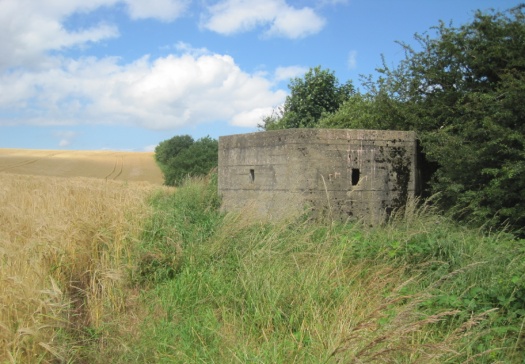
The type 22 pillbox was essentially designed for use by riflemen with provision for him to rest his elbow and ammunition clip on a wooden shelf mounted on iron bars built into the wall, a little below the loophole. There are 1,347 Type 22 pill boxes recorded in the UK.

Looking over the old A19, the housing estate of ‘Overdene’ can be viewed. In the middle thirties new changes were taking place in the parish with the development of new housing. Mr Henry Crow a Registrar of Births Deaths and Marriages with offices in both Seaham and Easington decided that he would like to build a bungalow on the corner of the old A19 and the summit of the church bank. To obtain this particular site he had to purchase a small field and in 1933 Mr Hugh Kirton a Seaham Harbour builder was contracted to build the bungalow. Realising the potential of the site Mr Kirton purchased the remaining land and commenced the development of ‘Overdene Estate’ in 1935.
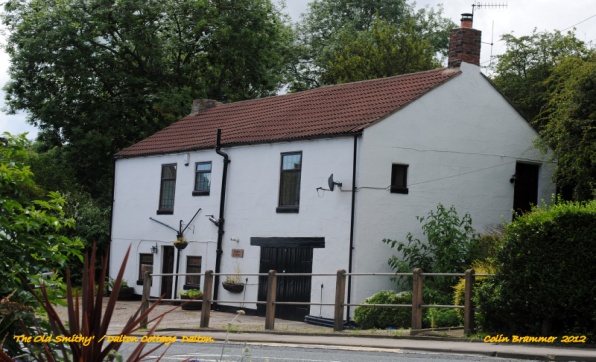
Our next building of note is the Blacksmiths shop or ‘Old Smithy’ more commonly known today as Dalton Cottage. Thomas Linton lived in the Old Smithy and was the local blacksmith, he purchased Colpitts farm from where he supplied horses for the pony and trap transport service

The Times Inn was built by Thomas Linton around 1820. In the late fifties / early sixties there were two public amenities which no longer exist, a telephone box stood at the gable of Dunelm Terrace, and a gentleman’s outside convenience for patrons of the hostelry and walkers making their way to and from Murton Colliery. This path was also known to be the corpse road, bodies wrapped in a sheath making their way to St Andrews for burial.

Looking up at the larger window on the left and facing Dunelm Terrace was the ‘big room’ which was used for wedding receptions, flower shows and meetings. It is verified that the inaugural meeting of the Dalton le Dale Woman’s Institute was held in this the ‘big room.’ I recall, in the chimney breast corner of the back room, there was a ‘dumb waiter’ which was used to hoist ale from the bar to the assembled guests upstairs. [It also hoisted young boys who lived nearby,] on rainy days. As young boys we used to stuff paper inside the large cast iron drainpipes and set them alight, what a loud frightening exciting noise it made.
Following the path towards the A19 which was opened in 1983, was sited on the crest of the hill ’Dalton Allotment Society’ possibly 50/60 allotments, mostly hen crees housing chickens for their eggs, and vegetables for the home. The society had it’s own fresh water well, which was covered by two hinged batten doors and could be climbed down inside following a drought period.
As we reach the bridle path which was known as the ‘Dene’ we turn left which brings us back to the old A19. Had we gone right in the early sixties, it would have brought us into Murton, Colliery passing by someone storey miners cottages with allotments adjacent known as Dene Terrace.
Underneath the green pasture land lies the household waste of residents of the former Easington District Council. It was one of two land fill sites the council possessed and the dumping of waste materials continued for several years until the late fifties early sixties. Everything from waste material, household goods, construction materials, glass, and coal ashes that continued to burn and light up the night sky.

Heading towards Cold Hesledon, we pass on our right ‘Glebe Villa’ by far the largest house within the parish. Built in 1847 it originally, housed Curates, who would preach to the residents of a wider community. Rev James Humphrey Brown was resident in 1866-67. The Rev Udney Allen Vicar of St Andrews also resided here until his appointment to Holy Trinity in 1877.
In later years Glebe Villa, became the home of Lord Londonderry’s mining agent, whose responsibility it was to ensure the running and profitability of his Lordships pits in Seaham . When Hawthorn Towers was demolished 50/60s it is thought one of its staircases was installed within the Villa. More recently Glebe Villa was purchased and is now in private hands.
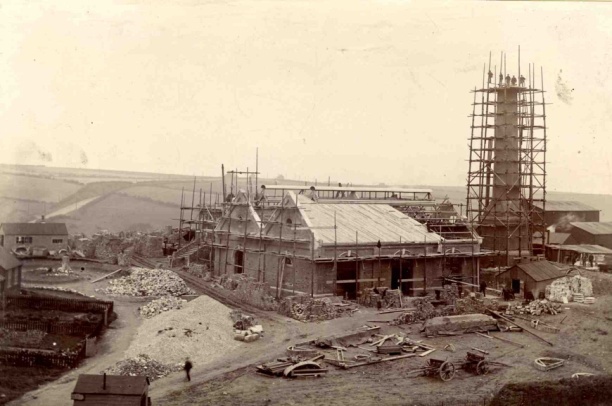
Virtually opposite the ‘Glebe,’ and along a narrow leafy lane stands North Dalton Pumping Station. Bought from the Ecclesiastical Commissioners in 1904 for the sum of £450.00 under the Water Authorities Act 1891. Built to supply the demands of the steadily increasing population The borehole is 31inches in dia,to 467ft-4in from the surface, then 29inch steel tubes to 187ft to the bottom of the limestone.
Total construction cost = £53,849-9-9d
Continuing to walk in a southerly direction our next port of call is Cold Hesledon, or to locals the Water Works. Hailing from the water works you would be known as a Waterwaggy.

Until 1830 Cold Hesledon was a rural agricultural village, but, in 1831 a waggonway running from the new South Hetton colliery to Seaham Harbour saw the beginnings of growth as a industrial village. It was in 1880 that the village began to increase in size as it became home to many miners who were employed at the nearby Murton Colliery. A long line of housing stretched from the bridge at the Pemberton Arms [Braddyll Arms] to the Social club opposite North Cresent which in the early days was part of the parish of Dalton le Dale. The street had a post office with Mr and Mrs Burns as the last post master. A branch of the Murton Co-operative store and Skilbecks corner shop were the places to purchase groceries and provisions. Cold Hesledon School provided an education for many Dalton residents. Mr Argument was the Headmaster. It was during the early 70s that the demolition of Cold Hesledon began with, many residents moving to newly built housing on the Cornwall Estate. Some experiencing hot running water and inside toilets for the first time in their lives. Hesldeon Terrace, Darcy Place, North Crescent, South Crescent, St Andrews Terrace, and the Waterworks club existed no more.

Dalton-le-Dale Water Pumping Station

1.76 miles from the sea, the main well is 468ft deep and 20ft below the limestone strata. 10.00 acres of land was acquired from Mr. R. Pemberton at a cost of £1985-0-0d. Costs included a diver at £500. Engines and boilers £3986-17-9d. Houses temp and permanent £1011-8-7d Total cost £158-541-7-6d. Built in the Venetian Gothic style by Thomas Hawksley for the Sunderland and South Shield Water Company in 1873/9. Members of the History Society have visited the building recently.
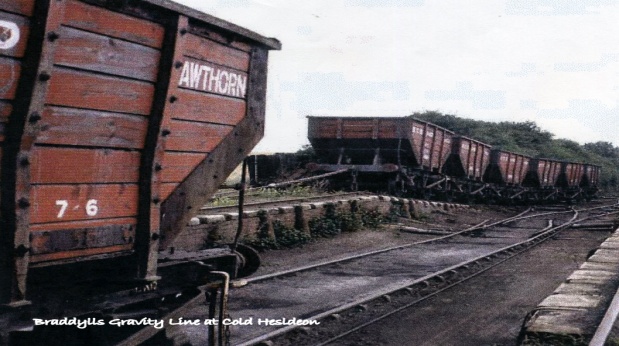
The main section of the Rainton and Seaham railway was completed in 1831. Almost immediately work began to construct a second line from the new harbour to the hinterland, paid for by Colonel Braddyll owner of the new pit at South Hetton. This, the South Hetton and Seaham line [aka The Braddyll Railway] also utilised gravity on its final stages and was completed in 1833. It ran from the ‘New winning’ past the still tiny hamlet of Murton, on past the ancient village of Cold Hesledon and through green fields down to the cliff tops and eventually into the docks. This now defunct railway is regularly referred to as the ‘yellow brick road’
Caterpillar Wood, so called because of its profile which can be seen as far away as Seaham Hall.
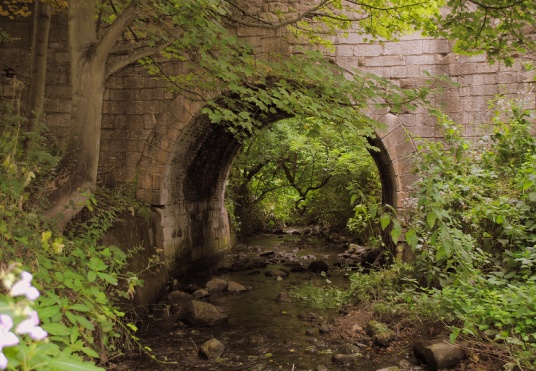
Stoney Cut derived it’s name from the excavation of the Hetton Railway through the rock strata. Somehow the name has been used to describe the bridleway from caterpillar wood to Dalton Bridge. This pathway was the original Newcastle to Stockton road for travellers moving north and south through the district. The Dalton Bridge’s claim to fame refers to the story of Oliver Cromwell who passed through travelling from Sunderland to Easington on his tour of the north following the Civil War. The story goes that St Andrews church was saved from attack because the large chestnut tree hid it from view as Cromwell and his men passed by. However the chestnut tree was not introduced from America until the 18th Century. Cromwell passed by in the 17th Century, thereby making the story a myth.
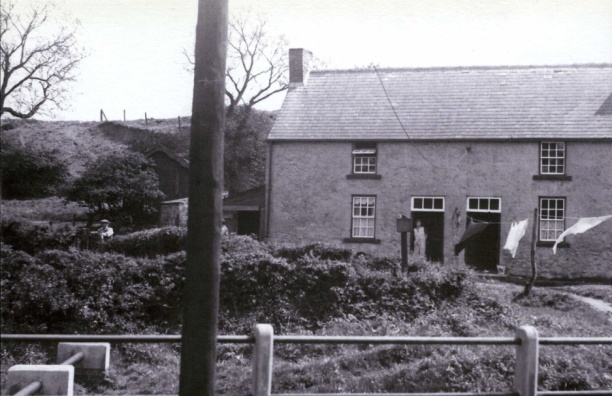
Travellers approaching the village from the South on their way North would veer to the left and pass by Burnside Cottages. At this location was sited a ford, allowing people to cross the beck, for those seeking shelter an Inn stood on the site of the cottages.
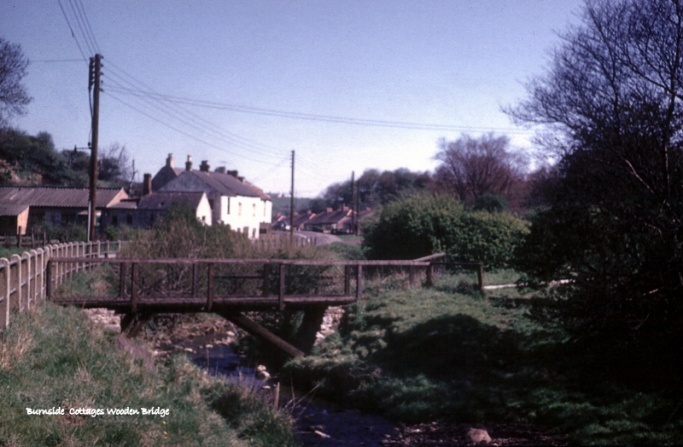
The wooden bridge leading to Burnside cottages, with the ford in the foreground
With the construction of Dalton Bridge in 1789 it resulted in the re-routing of the thoroughfare.
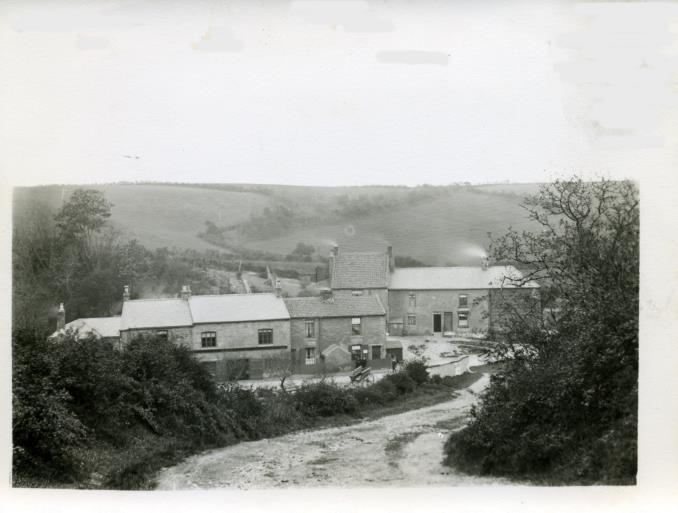
Reaching the village there are a number of vacant and overgrown sites. These were in fact the eastern edge of the village. Property development edged eastwards as buildings were abandoned because of poor living conditions. The Burnside Works was home to the Dickeson family who were Blacksmiths and Cartwrights. The business looked after the horse drawn carriages and traps which plied there services from the church to Dawdon Dene.
East End cottages were adjacent to Frouds Cottages and the lane which ran to Cragdale Villas. Over the road were the ‘netties’ for house in the immediate vicinity.

Easter Monday April 6th 1953 the new Church Hall opens. Mr Robert Wright and his father Andrew, who lived Dale Terrace seen laying the early brickwork. A dedication service was held in St Andrews Church with the Archdeacon of Durham the Venerable Egbert de Lucas Grey conducting.
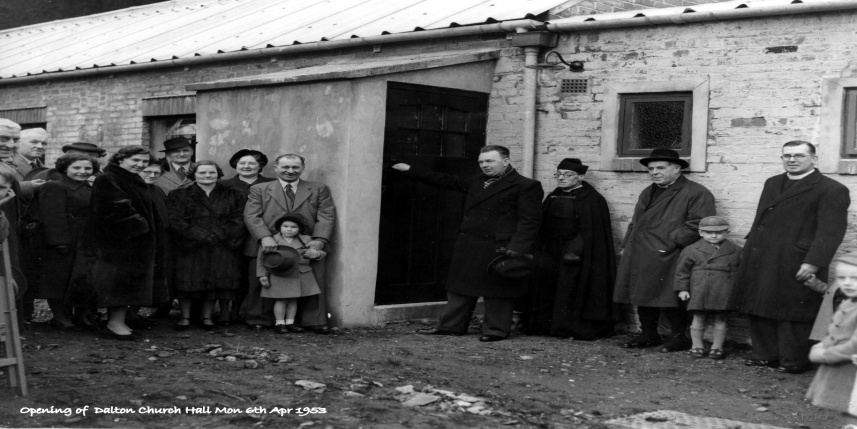
The opening ceremony was performed by Mr E Irwin, who was a Captain in the Church Army and who was the originator.
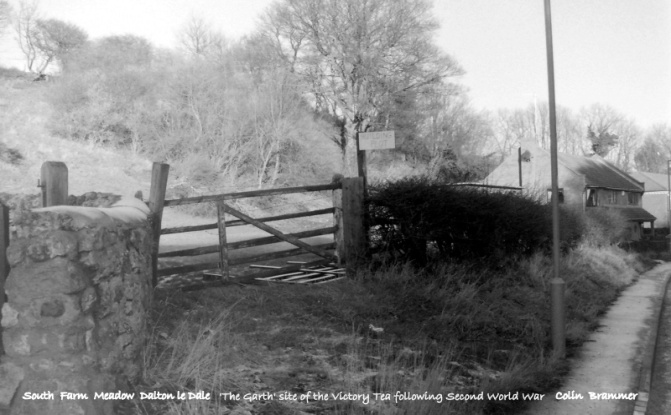
In common with cities, towns and villages throughout the length and breadth of the Country, Dalton le Dale joyfully celebrated the return to peaceful days. On Saturday Sept 29th 1945 a Victory tea was held on a parcel of land adjacent to South Farm.

South Farm; A family of Quakers named Mounsey were loaned the granary as a large bedroom and the cart shed as a dining hall for the convenience of some twenty poor children from the East End of Sunderland who could not afford a holiday for their Daughters. They were collected from Seaham Railway Station by Mr Wilson who owned the farm on one of his rollies and transported to South Farm. Following tea and washing up they would assemble on the village green opposite and play games such as rounders and skippy.
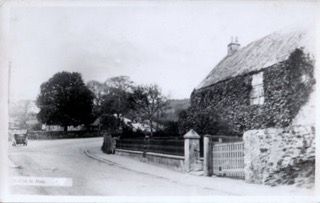
In 1273 the Prior and Convent endowed the Vicarage of Dalton together with other offerings a plot of land to which a vicarage was to be built. In 1871 when a Mr Gatt purchased the house from the Dean and Chapter, and alterations took place a beam of an old doorway revealed the date 1370.
Thos Sharpe Vicar at St Andrews 1655-1715 re built the vicarage adding the west end and had a stone placed above the doorway bearing his name and the date 1670. [This stone can be seen in the church porch.] Prior to this the upper storey was reached by a flight of stairs on the outside of the building. A later vicar, Peter Wilson 1715-1732 placed a sundial above the doorway dated 1722.
The vicarage was sold in the 1880’s probably following the creation of a new church Holy Trinity in Murton. Consequently Holy Trinity became the parish church and St Andrews was designated as a Chapel of Ease. September 21st 1962, workmen began demolishing the vicarage.
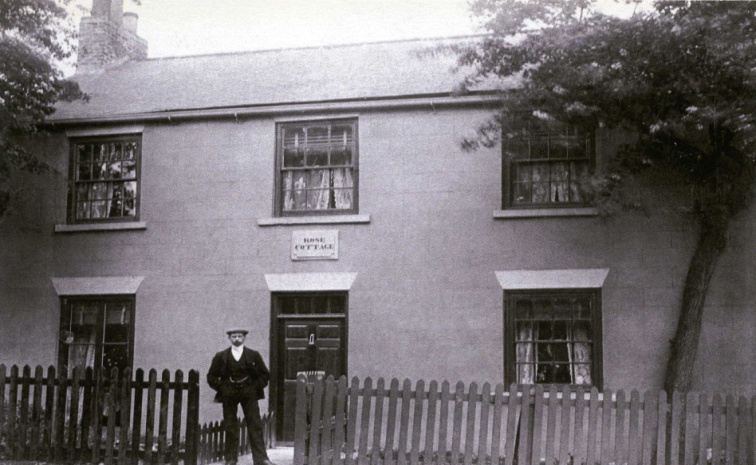
Rose Cottage; A delightful house, owned at one time by Matthew Preston which stood at the bottom of the church bank, with the a pear tree in the front garden. The cottage was demolished in 1912.

St Andrews Church is a feast for any historian and can claim to start it’s existence from Anglo Saxon Times. There are too many aspects of it’s history to squeeze into this guide so we recommend a booklet which is available for sale inside the Church.
It is the intention of the Dalton History group to produce an in depth document tracing all aspects of the Churches life.
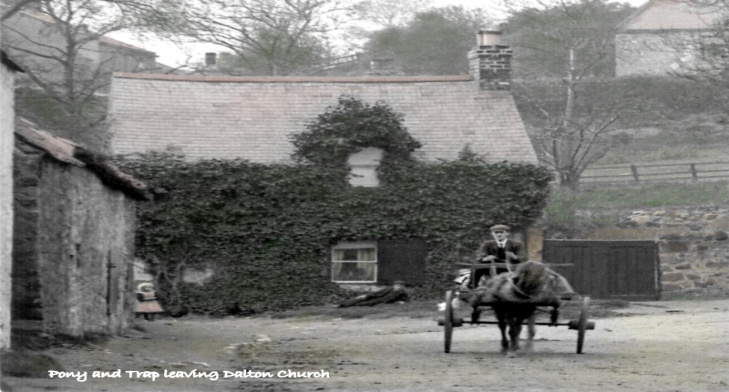
From the early part of this century owners of ponies and traps plied for hire carrying passengers from Dalton to Seaham Bank. It was not uncommon especially at weekends to find two dozen traps running to and fro through the Dene. The fare was 2d per person per journey. Bank Holiday Monday saw large crowds wishing to be transported to Seaham Hall Flower show, which was held in the grounds courtesy of Lord Londonderry, As there were no means of transport and for the fare of sixpence, passengers commencing their journey at Dalton would alight at the bottom of Seaham bank, walk to the top of the hill then realight continuing their onward journey to the Hall. The changing of ponies took place on the village green and ponies, could be watered at the church wall trough or at the spring water fountain in the dene. Many young men from, Dalton returning from war service invested their gratuity in a ‘yoke’.

There were three streets in Dalton, built around 1906 by the Gregson family. Dunelm Terrace[ 11 houses], St Cuthberts Terrace, [11 houses] and St Andrews Terrace [14 houses], the latter built on the site formerly occupied by Collpitts farm.
On behalf of Dalton History Group we hope you have enjoyed your Heritage walk this morning, and that we have whetted your appetite for more information. Why not come along and join our group, you will be made most welcome.
Now off to the Times for a well earned pint of their finest ale !!!